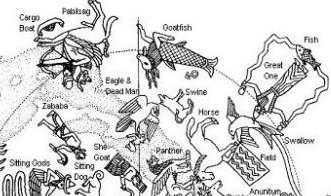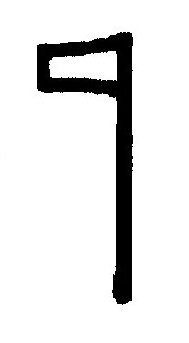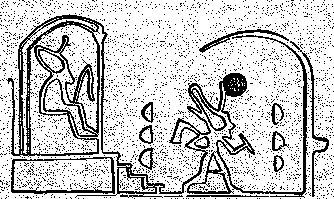The Mayan date November 15, 2720 BC could
possibly have corresponded to the position of Gb1-10 and to the
time when the Sun reached the end of the Eagle
constellation.

In rongorongo times this Tail of the
Eagle (evidently from τ
to ρ Aquilae) was beginning with the Sun in January 18
(383 = 18 + 365):
|
NOVEMBER 14 |
15 |
16 (320) |
17 |
18 (*242) |
 |
 |
 |
 |
 |
|
Gb1-9 |
Gb1-10 |
Gb1-11 (240) |
Gb1-12 |
Gb1-13 |
|
ε Pavonis, θ Sagittarii (302.3), γ Sagittae
(302.5), μ Pavonis (302.7 |
τ Aquilae
(303.8) |
20h (304.4)
η Sagittae (304.2), δ Pavonis (304.4) |
SHANG WEI (Higher Guard) = κ Cephei
(305.2), θ Sagittae
(305.4),
TSEEN FOO (Heavenly
Raft) = θ Aquilae (Ant.)
(305.6), ξ
Capricorni (305.8) |
TSO KE (Left Flag) = ρ Aquilae
(306.3) |
|
January 17 |
18 (383) |
19 (13
* 29½ + ½) |
20 |
21 |
|
°January 13 |
14 |
15 (*300) |
16 |
17 (382) |
|
SOLSTICE |
'December 22 |
23 (*277) |
CHRISTMAS EVE |
25 (359) |
|
"December 7 |
8 |
9 (*263) |
10 |
11 (345) |
|
NAKSHATRA DATES: |
|
MAY 15 (500) |
16 (136) |
17 |
18 |
19 |
|
DRUS = χ Carinae
(119.9) |
ω CANCRI
(120.2) |
8h (121.7)
χ Gemini
(121.0),
NAOS
= ζ Puppis
(121.3) |
ρ Puppis
(122.0),
HEAP OF FUEL = μ Cancri
(122.1), ζ
Monocerotis (122.3), ψ Cancri (122.6), REGOR = γ Velorum
(122.7) |
TEGMINE = ζ Cancri
(123.3) |
|
July 18 |
19 (200) |
20 |
21 (*122) |
22 / 7 |
|
°July 14 |
15 |
16 |
17 (*118) |
18 (199) |
|
SOLSTICE |
'June 22 |
23 (174) |
ST JOHN'S DAY |
25 (*96) |
|
"June 7 |
8 |
9 (*80) |
10 (161) |
11 |
 |
 |
 |
 |
 |
|
Ga2-25 |
Ga2-26 |
Ga2-27 (57) |
Ga2-28 |
Ga2-29 |
The Chinese star name for ρ Aquilae
is Left Flag (Tso Ke), located on the left
side of the bow of Antinous:
|
Sumerian SAG |
 |
Phoenician resh |
 |
Greek rho |
Ρ (ρ) |
|
... Resh
(Arabic: rāۥ)
is the twentieth letter of many Semitic
alphabets, including Phoenician, Aramaic,
Hebrew ... The word resh is usually
assumed to have come from a pictogram of a
head, ultimately reflecting Proto-Semitic
*raۥ(i)-.
The word's East Semitic cognate, rē-,
was one possible phonetic reading of the
Sumerian cuneiform sign for 'head' (SAG).

.jpg) |
In the C text
there is a hoea resembling
that in Ga2-26 and both are possibly representing the
opposite of the final phase of life, viz. birth (hanau):
 |
 |
 |
 |
 |
|
Cb4-19 |
Cb4-20 (91) |
Cb4-21 (484) |
Cb4-22 |
Cb4-23 |
And in E there is
a hoea in Gb6-3:
|
24th
and last period: |
 |
 |
 |
 |
 |
 |
 |
|
Eb5-29 |
Eb5-30 |
Eb5-31 (180) |
Eb5-32 |
Eb5-33 |
Eb5-34 |
Eb5-35 |
 |
 |
 |
 |
 |
 |
|
Eb6-1 |
Eb6-2 |
Eb6-3 (187) |
Eb6-4 |
Eb6-5 |
Eb6-6 |
 |
 |
 |
 |
 |
 |
 |
|
Eb6-7 |
Eb6-8 |
Eb6-9 (193) |
Eb6-10 |
Eb6-11 |
Eb6-12 |
Eb6-13 |
 |
 |
 |
 |
 |
 |
|
Eb6-14 |
Eb6-15 (525) |
Eb6-16 |
Eb6-17 |
Eb6-18 |
Eb6-19 |
With a niu (young coco-nut palm
tree) arriving 2 days later we can guess this was a
place where the Old One was rejuvenating himself.

There are 6 new 'feathers' in the branch growing up in front.
... In late
September or early October 130, Hadrian and his
entourage, among them Antinous, assembled at Heliopolis
to set sail upstream as part of a flotilla along the
River Nile. The retinue included officials, the Prefect,
army and naval commanders, as well as literary and
scholarly figures. Possibly also joining them was Lucius
Ceionius Commodus, a young aristocrat whom Antinous
might have deemed a rival to Hadrian's affections. On
their journey up the Nile, they stopped at Hermopolis
Magna, the primary shrine to the god Thoth.
It was
shortly after this, in October [in the year A.D.] 130 -
around the time of the festival of Osiris - that
Antinous fell into the river and died, probably from
drowning. Hadrian publicly announced his death, with
gossip soon spreading throughout the Empire that
Antinous had been intentionally killed. The nature of
Antinous's death remains a mystery to this day, and it
is possible that Hadrian himself never knew; however,
various hypotheses have been put forward.
One
possibility is that he was murdered by a conspiracy at
court. However, Lambert asserted that this was unlikely
because it lacked any supporting historical evidence,
and because Antinous himself seemingly exerted little
influence over Hadrian, thus meaning that an
assassination served little purpose. Another suggestion
is that Antinous had died during a voluntary castration
as part of an attempt to retain his youth and thus his
sexual appeal to Hadrian. However, this is improbable
because Hadrian deemed both castration and circumcision
to be abominations and as Antinous was aged between 18
and 20 at the time of death, any such operation would
have been ineffective. A third possibility is that the
death was accidental, perhaps if Antinous was
intoxicated. However, in the surviving evidence Hadrian
does not describe the death as being an accident;
Lambert thought that this was suspicious.
Another possibility is that Antinous represented a
voluntary human sacrifice. Our earliest surviving
evidence for this comes from the writings of Dio
Cassius, 80 years after the event, although it would
later be repeated in many subsequent sources. In the
second century Roman Empire, a belief that the death of
one could rejuvenate the health of another was
widespread, and Hadrian had been ill for many years; in
this scenario, Antinous could have sacrificed himself in
the belief that Hadrian would have recovered.
Alternately, in Egyptian tradition it was held that
sacrifices of boys to the Nile, particularly at the time
of the October Osiris festival, would ensure that the
River would flood to its full capacity and thus
fertilize the valley; this was made all the more urgent
as the Nile's floods had been insufficient for full
agricultural production in both 129 and 130. In this
situation, Hadrian might not have revealed the cause of
Antinous's death because he did not wish to appear
either physically or politically weak. Conversely,
opposing this possibility is the fact that Hadrian
disliked human sacrifice and had strengthened laws
against it in the Empire
...

And with Eb6-3 as glyph 187 it is easy to
imagine the beginning of side b coincided with January
1, because we have found day 187 (July 6) to be of central importance.
This was at Ga8-22 where there was an inversion:
|
NOVEMBER 1 |
2
(306) |
3
(*227) |
4 |
5 |
 |
 |
 |
 |
 |
|
Ga8-22 |
Ga8-23 |
Ga8-24 (227) |
Ga8-25 |
Ga8-26 |
|
19h
(289.2)
λ
Aquilae (Ant.) (289.1), γ Cor. Austr (289.3),
τ
Sagittarii
(289.4), ι Lyrae (289.5), δ Cor. Austr. (289.8)
|
Al Baldah-19
AL
BALDAH
= π Sagittarii,
ALPHEKKA MERIDIANA
= α Cor. Austr.
(290.1), β Cor. Austr. (290.2) |
ALADFAR = η Lyrae
(291.1),
NODUS II = δ Draconis
(291.5), ψ Sagittarii (291.6), τ Draconis
(291.7), θ Lyrae (291.8) |
ω
Aquilae (292.1),
ρ
Sagittarii
(292.6), υ Sagittarii (292.7) |
π
Draconis,
ARKAB PRIOR = β¹ Sagittarii
(293.0),
ARKAB POSTERIOR = β² Sagittarii,
ALRAMI
= α Sagittarii
(293.2),
χ
Sagittarii
(293.6) |
|
January 4 |
5
(*290) |
6 |
7
(372) |
8 |
|
°December 31 |
°January 1 |
2
(*287) |
3
(368) |
4 |
|
'December 8 |
9 |
10
(*264) |
11 (345) |
12 |
|
"November 24 |
25 (329) |
26
(*250) |
27 |
28 |
|
NAKSHATRA DATES: |
|
MAY
3 (123) |
4 |
5
(*45) |
6
(*411) |
7
(492) |
|
WEZEN (Weight)
= δ Canis Majoris
(107.1), τ Gemini (107.7), δ Monocerotis (107.9) |
no star listed (108) |
λ Gemini (109.4),
WASAT (Middle)
= δ Gemini
(109.8) |
no star listed (110) |
ALUDRA
(Virgin) = η Canis Majoris
(111.1),
PROPUS = ι Gemini
(111.4),
GOMEISA = β Canis Minoris
(111.6) |
|
July
6 (*107) |
7 |
8 |
9
(190) |
10 |
|
°July 2 |
3
(184) |
4 |
5 |
6
(*107) |
|
'June 9 |
10
(161) |
11 |
12 |
13
(*84) |
|
"May
26 |
27 |
28
(148) |
29 |
30
(*70) |
 |
 |
 |
 |
 |
|
Ga2-13 |
Ga2-14 |
Ga2-15 (45) |
Ga2-16 |
Ga2-17 |
Probably 187 was used
also for the heliacal days to July 6 at
Rogo on side b of the tablet:
|
APRIL 27 (*37) |
 |
|
Gb6-20 (402 = 229 + 173) |
|
SIRIUS
= α Canis Majoris
(101.2), ψ5 Aurigae (101.4), ν Gemini (101.6),
ψ6 Aurigae (101.7) |
|
June
30 (181) |
... The month, which takes its name from Juppiter the
oak-god, begins on June 10th and ends of July 7th.
Midway comes St. John's Day, June 24th, the day on which
the oak-king was sacrificially burned alive. The Celtic
year was divided into two halves with the second half
beginning in July, apparently after a seven-day wake, or
funeral feast, in the oak-king's honour ...
Furthermore, we have identified the distance
84 (= 420 / 5) days from hoea to the place where
the Ruler
might have gone away for a while.

18 * 29½ = 531 as in
Eb5-31.
| G text: |
| MAY 16 (136) |
83 |
AUGUST 8 (220) |
 |
 |
| Ga2-26 (56, 299) |
Ga5-30 (140, 383) |
| July 19 (200) |
October 11 (284) |
|
ω CANCRI (*120) τ Aquilae (*303) |
(*204) υ Andromedae (*387) |

187 (Eb6-3) + 84 = 271 (September 28):
 |
 |
 |
 |
 |
 |
 |
| Eb8-6 |
Eb8-7 |
Eb8-8 |
Eb8-9 (271) |
Eb8-10 |
Eb8-11 |
(600) |
| te kahi |
kua oho ku tutu |
koia - e ua |
huki ma te papamea |
hoko huki erua |
| Tutu 1. Circle of fishing nets arranged in the shape of a funnels or baskets. 2. To light a fire; he-tutu i te ahi: to burn something. 3. To hit, to strike, to beat. Tūtś, to shake (something) clean of dust or dirt; he-tūtś te oone o te nua, to shake the dirt off a nua cape. Tutuhi, to reject the responsibility for a mistake onto one another, to blame one another for a mistake (see tuhi). Tutuki, to stumble, to trip. O tutuki te va'e, in order not to trip. Tutuma, firebrand, partly burnt stick. Tuturi, to kneel. Vanaga.
1. To beat bark for cloth. PS Pau., Mgv., Mq., Ta.: tutu, id. Sa., To., Fu.: tutu, id. 2. A broom, to sweep, to clean. Mq.: tutu, to beat out the dust. 3. To shake, to winnow. Mgv.: tutu, to tremble, to leap. Mq.: tutu, to shake. 4. To kindle, to light, to ignite, to set fire, to burn. Mq.: tutu, to burn, to set fire. 5. To stand; hakatutu, to set joists. P Mgv., Mq.: tutu, to stand upright. Ta.: tu, id. Tutua (tutu 1): board on which bark is beaten into cloth. PS Mgv.: tutua, a cloth beater. Mq., Ta.: tutua, wood on which cloth is beaten. Sa., Fu.: tutua, id. Tutui: tutui ohio, chain, tutui kura, shawl. Mq.: tuitui kioé, chain. Tutuki: shock, contusion, to run against, to collide; tukukia, to run foul of. P Pau.: tukituki, to strike, to pound, to grind. Mgv.: tukia, to strike against, shock, concussion. Mq.: tutuki, id. Ta.: tui, id. Tutuma: 1. (tutu - ma) a live coal. 2. Tree trunk T (? tumu). Tutumata, ligament of the eye, orbit, eyelid. T (tutumate, eyelid G). Tutuu, bristling. Churchill. |
| Papa 1. Underground rock; motionless; rocky sea bottom; large flat stone; figuratively: tagata papa important man, author of great works. 2. Wooden plank currently used much like a surf-board in the sport called garu; it was formerly called papa gaatu mo te garu, because it was made from dry totora leaves woven into the shape of a plank. 3. To line up things side by side on a flat surface, for instance, to line up fish on top of a flat stone. Vanaga.
Shoulderblade. Papapapa, a chill, to shiver, to tremble, to shudder. Churchill. |
| JULY 26 |
27 |
28 |
29 (210) |
30 (*131) |
 |
 |
 |
 |
 |
| Ga5-17 |
Ga5-18 (128) |
Ga5-19 |
Ga5-20 |
Ga5-21 |
| Al Įwwā'-11 / Shur-mahrū-shirū-18 (Front or West Shur?) Sombrero Galaxy = M104 Virginis (191.1), ρ Virginis (191.4), PORRIMA = γ Virginis, γ Centauri (191.5) |
ι Crucis (192.2), β Muscae (192.5), MIMOSA = β Crucis (192.9) |
no star listed (193) |
κ Crucis (194.4), ψ Virginis (194.5), μ Crucis, λ Crucis (194.6), ALIOTH (Fat Tail) = ε Ursae Majoris, ι Oct. (194.8) |
MINELAUVA = δ Virginis (195.1), COR CAROLI = α Canum Ven. (195.3) |
| September 28 |
29 (*192) |
30 (273) |
October 1 |
2 |
| NAKSHATRA DATES: |
| JANUARY 25 |
26 |
27 (392) |
28 |
29 (*314) |
| ξ Phoenicis (9.0), ρ Tucanae (9.1), DENEB KAITOS = β Ceti, η Phoenicis (9.4), AL NITHĀM = φ¹ Ceti (9.6) |
ACHIRD = η Cassiopeiae (10.7) |
Legs-15 ν Andromedae (11.0), φ² Ceti (11.1), ρ Phoenicis (11.2), η Andromedae (11.4) |
CIH (Whip) = γ Cassiopeiae, λ Tucanae (12.4), φ³ Ceti (12.6), μ Andromedae (12.8) |
φ4 Ceti (13.2) |
| March 30 |
31 (*375) |
April 1 (91) |
2 |
3 |

|





.jpg)






























